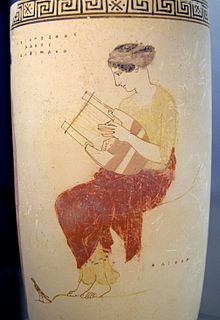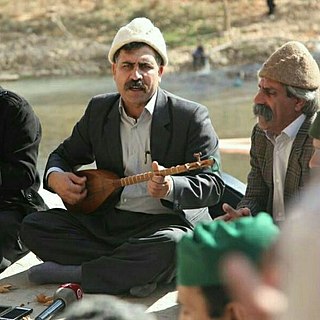Related Research Articles

The harp is a stringed musical instrument that has a number of individual strings running at an angle to its soundboard; the strings are plucked with the fingers. Harps can be made and played in various ways, standing or sitting and in orchestras or concerts. Its most common form is triangular in shape and made of wood. Some have multiple rows of strings and pedal attachments.

String instruments, stringed instruments, or chordophones are musical instruments that produce sound from vibrating strings when a performer plays or sounds the strings in some manner.

The lyre is a stringed musical instrument that dates back to 1400 BC in ancient Greece. It is known for its use in Greek classical antiquity and later periods. The instrument was created and used earlier, around 2600 BC, in Egypt.

The hurdy-gurdy is a string instrument that produces sound by a hand-crank-turned, rosined wheel rubbing against the strings. The wheel functions much like a violin bow, and single notes played on the instrument sound similar to those of a violin. Melodies are played on a keyboard that presses tangents—small wedges, typically made of wood—against one or more of the strings to change their pitch. Like most other acoustic stringed instruments, it has a sound board and hollow cavity to make the vibration of the strings audible.

The crwth is a bowed lyre, a type of stringed instrument, associated particularly with Welsh music, now archaic but once widely played in Europe. Four historical examples have survived and are to be found in St Fagans National Museum of History (Cardiff); National Library of Wales (Aberystwyth); Warrington Museum & Art Gallery; and the Museum of Fine Arts, Boston (US).

Gusli is the oldest East Slavic multi-string plucked instrument, belonging to the zither family, due to its strings being parallel to its resonance board. Its roots lie in Veliky Novgorod in Novgorodian Rus'. It may have a connection to the Byzantine form of the Greek kythare, which in turn derived from the ancient lyre, or might have been imported from Western and Central Europe during the Middle Ages, when the zither had immense popularity. It has its relatives in Europe and throughout the world: kantele in Finland, kannel in Estonia, kanklės in Lithuania, kokles in Latvia, Zither in Germany, citera in the Czech Republic, psalterium in France and so on... Furthermore, the kanun has been found in Arabic countries, and the autoharp, in the United States. It is also related to such ancient instruments as Chinese gu zheng, which has a thousand-year history, and its Japanese relative koto. A stringed musical instrument called guslim is listed as one of the Me in ancient Sumer.

The jouhikko is a traditional, two- or three-stringed bowed lyre, from Finland and Karelia. Its strings are traditionally of horsehair. The playing of this instrument died out in the early 20th century but has been revived and there are now a number of musicians playing it.

The begena, also known as bagana is a ten-stringed box-lyre instrument from the Amhara people of Ethiopia, and is the sole melodic instrument devoted only to the zema, the spiritual part of Amhara music.
The barbiton, or barbitos, is an ancient stringed instrument related to the lyre known from Greek and Roman classics.

The Celtic harp is a triangular frame harp traditional to the Celtic nations of northwest Europe. It is known as cláirseach in Irish, clàrsach in Scottish Gaelic, telenn in Breton and telyn in Welsh. In Ireland and Scotland, it was a wire-strung instrument requiring great skill and long practice to play, and was associated with the Gaelic ruling class. It appears on Irish and British coins, the coat of arms of the Republic of Ireland, Montserrat, the United Kingdom and Canada as well as the flag of Montserrat.

The talharpa, also known as a tagelharpa or the stråkharpa, is a four-stringed bowed lyre from northern Europe. It was formerly widespread in Scandinavia, but is today played mainly in Estonia, particularly among that nation's Swedish community. It is similar to the Finnish jouhikko and the Welsh crwth. The instrument is still known in Finland.

The term Tanbur can refer to various long-necked string instruments originating in Mesopotamia, Southern or Central Asia. According to the New Grove Dictionary of Music and Musicians, "terminology presents a complicated situation. Nowadays the term tanbur is applied to a variety of distinct and related long-necked lutes used in art and folk traditions. Similar or identical instruments are also known by other terms." These instruments are used in the traditional music of Iran, India, Kurdistan, Armenia, Afghanistan, Azerbaijan, Pakistan, Turkey, Tajikistan, Kazakhstan, and Uzbekistan.

The gue is an extinct type of two-stringed bowed lyre or zither from the Shetland Isles. The instrument was described in 1809 by Arthur Edmondston in View of the Ancient and Present State of the Zetland Islands:
"Before violins were introduced, the musicians performed on an instrument called a gue, which appears to have had some similarity to the violin, but had only two strings of horse hair, and was played upon in the same manner as a violoncello."

The cithara was an ancient Greek musical instrument in the yoke lutes family. In modern Greek the word kithara has come to mean "guitar", a word which etymologically stems from kithara.

The Byzantine lyra or lira was a medieval bowed string musical instrument in the Byzantine Empire. In its popular form, the lyra was a pear-shaped instrument with three to five strings, held upright and played by stopping the strings from the side with fingernails. The first known depiction of the instrument is on a Byzantine ivory casket, preserved in the Bargello in Florence. Versions of the Byzantine lyra are still played throughout the former lands of the Byzantine Empire: Greece, Crete, Albania, Montenegro, Serbia, Bulgaria, North Macedonia, Croatia, Italy and Armenia.

A musical instrument is a device created or adapted to make musical sounds. In principle, any object that produces sound can be considered a musical instrument—it is through purpose that the object becomes a musical instrument. A person who plays a musical instrument is known as an instrumentalist. The history of musical instruments dates to the beginnings of human culture. Early musical instruments may have been used for rituals, such as a horn to signal success on the hunt, or a drum in a religious ceremony. Cultures eventually developed composition and performance of melodies for entertainment. Musical instruments evolved in step with changing applications and technologies.
The nares-jux (нарс-юх) or Siberian lyre is a musical instrument, a type of box-lyre, played by the peoples of the Khanty-Mansi Autonomous Okrug of Russian Siberia.
The Kemençe of the Black Sea or Kemençe of Laz is a Greek and Turkish traditional musical instrument. It belongs to the category of stringed bowed musical instruments. It has three strings, usually tuned to perfect fourths, usually tuned B-E-A. It is the pre-eminent musical folk instrument of the Greeks of Pontus. It seems to have been invented during the Byzantine years, between the 11th and 12th Centuries. The instrument is made of different types of wood.

The classicalkemenche, Armudî kemençe or Politiki lyra is a pear-shaped bowed instrument that derived from the medieval Greek byzantine lyre.

The veena, also spelled vina, comprises various chordophone instruments from the Indian subcontinent. Ancient musical instruments evolved into many variations, such as lutes, zithers and arched harps. The many regional designs have different names such as the Rudra veena, the Saraswati veena, the Vichitra veena and others.
References
- ↑ Folk harp journal. 1 January 1981. Retrieved 18 May 2012.
- ↑ Sibyl Marcuse (April 1975). A survey of musical instruments . Harper & Row. p. 403. ISBN 978-0-06-012776-3 . Retrieved 18 May 2012.
- ↑ Marjorie Mandelstam Balzer (1 November 1999). The Tenacity of Ethnicity: A Siberian Saga in Global Perspective . Princeton University Press. pp. 192–. ISBN 978-0-691-00673-4 . Retrieved 18 May 2012.
- ↑ Robert Auty; Arthur Thomas Hatto (31 December 1980). Traditions of Heroic and Epic Poetry: The traditions. Modern Humanities Research Association. ISBN 978-0-900547-72-0 . Retrieved 18 May 2012. - of instrument unknown elsewhere in Western Siberia ; one was a five-stringed lyre with a body shaped like a fish, and the other a swan-necked harp with nine or thirteen strings.
- ↑ Mare Kõiva; Kai Vassiljeva; Eesti Keele Instituut; Fr. R. Kreutzwaldi nimeline Kirjandusmuuseum (1995). Folk belief today. Estonian Academy of Sciences, Institute of the Estonian Language & Estonian Museum of Literature. p. 452. ISBN 978-9985-851-11-1 . Retrieved 18 May 2012.
- ↑ Péter Hajdú (1975). Finno-Ugrian languages and peoples . Deutsch. p. 234. ISBN 978-0-233-96552-9 . Retrieved 17 May 2012.